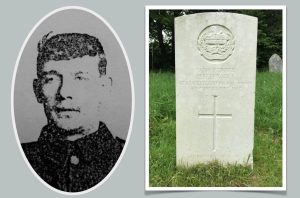10th Battalion, Gloucestershire Regiment

Richard Hubert Hanks (may have been known as Hubert) was born to general labourer Thomas Henry and Mary Jane Hanks (née Workman) on 6 March 1890 at Painswick where they were living at the time of the 1911 Census. The Census shows that they had six children, of whom only four were living at the time of the census and Hubert was the youngest son.
In that census Hubert is shown as being a bricklayer, unmarried and living with his parents in Painswick at Gloucester Street. Prior to enlisting in the Army he was employed by Burdock & Sons, builders in Painswick and he had also served with the town’s fire brigade for two and a half years.
Outside of his working time he was a church bellringer and had been a chorister at the local parish church and played cricket for Painswick Cricket Club. He had also been a member of the Church Lads’ Brigade and Boys’ Brigade.
He married Emma Elizabeth Foxwell on 21 December 1912 at Stroud and the couple had two children, Olive Susan Mary, born on 25 September 1913 and Hubert Francis Joseph born 24 November 1914.
Hubert joined the Army at Stroud on 1 January 1915 and was posted to the Gloucestershire Regiment’s 10th Battalion. He was initially billeted at Cheltenham and from April 1915 was on Salisbury Plain. On 9 August 1915 he landed in France with his battalion, who, on 17 August became part of 1st Brigade, 1st Division.
The 10th Glosters were part of the ‘New Army’ raised at Lord Kitchener’s behest and with the 8th Battalion, Royal Berkshire Regiment had been drafted into 1st Brigade, to replace the 1st Coldstream Guards and 1st Scots Guards.
Untried in battle they were to find themselves in the front line when the Battle of Loos opened on 25 September 1915. Starting out from west of the Loos to La Bassee Road 1st Brigade’s task was to capture the German first and second line trenches and to continue as far as Hulluch.
They were to be supported by the first British use of chlorine gas, unfortunately there was hardly any wind in the area of the 10th Glosters’ trenches and instead of it rolling towards the German lines it stayed put and many men were affected by it. The attack went in at 6.30am and it overran the Bois Carre and got into the German front line but there were severe casualties and the attack faltered between the German front line and the Loos – La Bassee Road. Hubert Hanks was wounded in the left knee during the attack. He would have been treated initially at a Regiment Aid Post before being sent on to a Casualty Clearing Station and then on to a Base Hospital, where he spent five weeks, before being transferred back to England and to Trent Bridge Military Hospital, Nottingham. This was located in the pavilion of Trent Bridge Cricket Ground.
On 23 November 1915 surgeons were forced to amputate Hubert’s damaged leg. He never recovered from the operation, becoming progressively ill and died eleven days later on 4 December 1915, aged 25. He left a widow and two children: his widow appears to have re-married on 15 March 1919.
His funeral took place on 8 December at Painswick Parish Church and there was a full report in the Gloucestershire Echo of 9 December. The funeral was with ‘full fireman’s honours’, as befitted a former member of Painswick Fire Brigade and the coffin was borne from the church by members of the Brigade, bearing a Union Flag, a fireman’s helmet, tunic and belt and at the lychgate was placed on a fire engine to take it to Painswick Cemetery for burial. His grave is now marked by a standard CWGC headstone and he is commemorated on the Painswick War Memorial.
Researched by Graham Adams 30 October 2015
